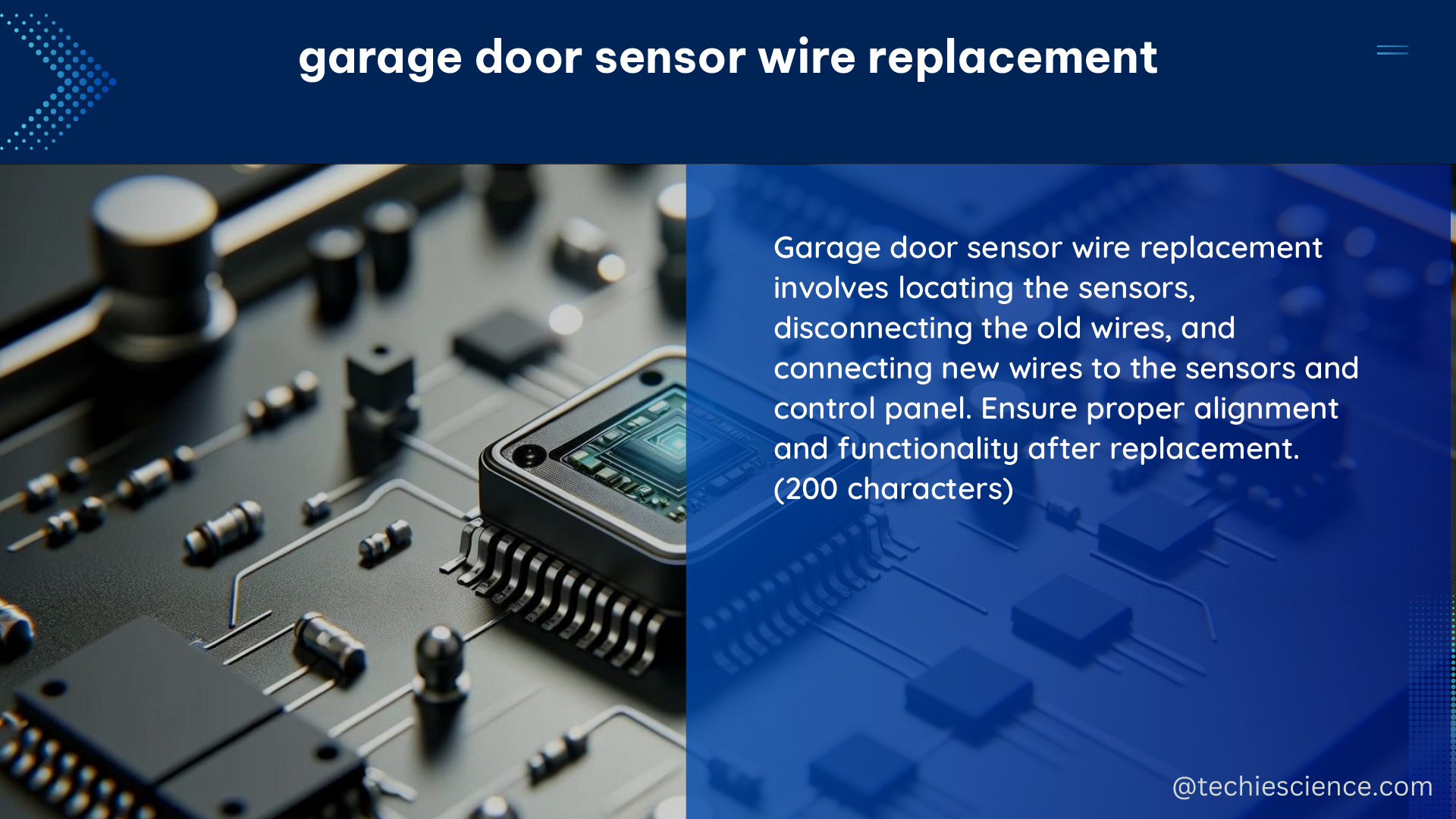Garage door sensor wires are an essential component of modern garage door systems, responsible for ensuring the safe and reliable operation of your garage door. These low-voltage, low-current wires are typically made of 18 AWG or 22 AWG wire, often sold as thermostat wire, security system wire, central vac wiring, or telephone station wire. Replacing these wires can be a straightforward task, but it’s crucial to understand the proper techniques and considerations to ensure a successful and safe installation.
Understanding Garage Door Sensor Wires
Garage door sensors are designed to detect the presence of objects in the path of the closing door, preventing it from causing damage or injury. These sensors are typically connected using a pair of wires, with one wire carrying the 24VDC power supply and the other wire transmitting the sensor signal back to the garage door opener.
The low-voltage and low-current nature of these wires make them suitable for use with 18 AWG or 22 AWG wire, which are readily available and easy to work with. These wires are often sold in various colors, allowing for easy identification and organization during the installation process.
Preparing for Garage Door Sensor Wire Replacement

Before beginning the replacement process, it’s essential to ensure that the new wires are the correct gauge and length for your specific garage door system. Measure the distance between the sensors and the garage door opener, and select the appropriate wire length to ensure a secure and tidy installation.
Additionally, it’s crucial to ensure that the sensor bracket is mounted no higher than six inches from the ground. This positioning is crucial for the proper functioning of the sensors, as they need to be able to detect objects in the path of the closing door.
Replacing Garage Door Sensor Wires
-
Disconnect the Power: Begin by disconnecting the power to your garage door opener, either by unplugging it from the wall or turning off the circuit breaker.
-
Locate the Sensor Wires: Identify the wires connecting the garage door sensors to the opener. These wires are typically low-voltage and low-current, often running along the wall or ceiling.
-
Disconnect the Existing Wires: Carefully disconnect the existing wires from the sensors and the garage door opener, taking note of the wire colors and their respective connections.
-
Prepare the New Wires: Cut the new 18 AWG or 22 AWG wires to the appropriate length, ensuring they are long enough to reach from the sensors to the opener without excess slack.
-
Connect the New Wires: Connect the new wires to the sensors using the butterfly knot and nut provided with the new sensors. Ensure that the connections are secure and that the wires are not damaged during the process.
-
Route the New Wires: Carefully route the new wires from the sensors to the garage door opener, using cable clips or staples to secure the wires and prevent them from becoming a tripping hazard.
-
Connect the Wires to the Opener: Connect the new wires to the appropriate terminals on the garage door opener, matching the wire colors to the corresponding connections.
-
Test the Sensors: Restore power to the garage door opener and test the sensors to ensure they are functioning correctly. Observe the sensor lights and ensure that the door reverses when an object is placed in its path.
Troubleshooting Garage Door Sensor Wires
If the sensors are not working correctly after the wire replacement, there are a few potential issues to consider:
-
Damaged Wires: It’s possible that the new wires themselves are damaged or have been improperly connected. Carefully inspect the wires and connections for any issues.
-
Incorrect Wiring Configuration: In some cases, 8-conductor data wire may have been used to wire the door sensors, in which case the colors used at the opener end would need to be checked to determine the correct wiring configuration.
-
Sensor Alignment: Ensure that the sensor brackets are mounted no higher than six inches from the ground and that the sensors are properly aligned with each other.
If you encounter any issues during the replacement process or have concerns about the proper functioning of your garage door sensors, it’s always best to consult a professional garage door technician for assistance.
Conclusion
Replacing garage door sensor wires is a straightforward task that can be accomplished by most DIY enthusiasts. By understanding the technical specifications of these wires, following proper installation procedures, and troubleshooting any issues that may arise, you can ensure the safe and reliable operation of your garage door system. Remember to always prioritize safety and consult a professional if you have any doubts or concerns during the replacement process.
References
- Is it possible to splice this garage door safety sensor wire with some other wire?
- How to Replace Garage Door Sensors
- Linear Garage Door System – Replacing Garage Sensors/Sensors
- Wiring question – Garage Door Sensor
- How to Replace Garage Door Sensors

The lambdageeks.com Core SME Team is a group of experienced subject matter experts from diverse scientific and technical fields including Physics, Chemistry, Technology,Electronics & Electrical Engineering, Automotive, Mechanical Engineering. Our team collaborates to create high-quality, well-researched articles on a wide range of science and technology topics for the lambdageeks.com website.
All Our Senior SME are having more than 7 Years of experience in the respective fields . They are either Working Industry Professionals or assocaited With different Universities. Refer Our Authors Page to get to know About our Core SMEs.